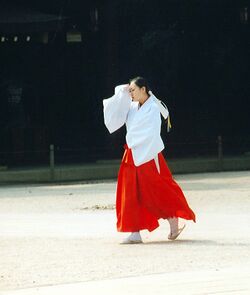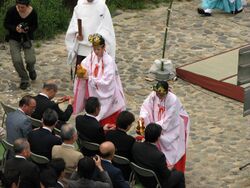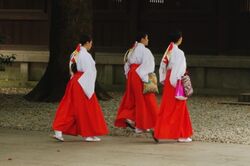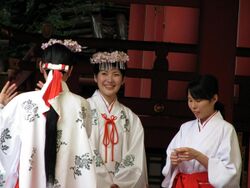Religion:Miko
A miko (巫女), or shrine maiden,[1][2] is a young priestess[3] who works at a Shinto shrine. Script error: The function "transl" does not exist. were once likely seen as shamans,[4] but are understood in modern Japanese culture to be an institutionalized[5] role in daily life, trained to perform tasks, ranging from sacred cleansing[4] to performing the sacred Script error: The function "transl" does not exist. dance.[6]
Appearance
The traditional attire of a Script error: The function "transl" does not exist. is a pair of red hakama (緋袴) (divided, pleated trousers), a white Script error: The function "transl" does not exist. (a predecessor of the kimono), and some white or red hair ribbons. In Shinto, the color white symbolizes purity.[citation needed] The garment put over the Script error: The function "transl" does not exist. during Script error: The function "transl" does not exist. dances is called a chihaya (千早).
Traditional Script error: The function "transl" does not exist. tools include the Lua error in Module:Lang/utilities at line 268: attempt to call field '_transl' (a nil value).,[7] the tamagushi (玉串) (offertory Script error: The function "transl" does not exist.-tree branches),[8] and the Lua error in Module:Lang/utilities at line 268: attempt to call field '_transl' (a nil value)..[9]
Script error: The function "transl" does not exist. also use bells, drums, candles, Script error: The function "transl" does not exist., and bowls of rice in ceremonies.
Definition
The Japanese words Script error: The function "transl" does not exist. and Script error: The function "transl" does not exist. ("female shaman" and "shrine maiden" respectively)[10] are usually written 巫女[10] as a compound of the kanji 巫 ("shaman"), and 女 ("woman").[10] Script error: The function "transl" does not exist. was archaically written 神子 ("kami" + "child")[10] and 巫子 ("shaman child").[10]
The term is not to be confused with Script error: The function "transl" does not exist. meaning "prince", "princess" or "duke", and which is otherwise variously spelt 御子 ("august child"), 皇子 ("imperial child"), 皇女 ("imperial daughter", also pronounced Script error: The function "transl" does not exist.), 親王 ("prince") or 王 ("king", "prince" or "duke"). These spellings of Script error: The function "transl" does not exist. were commonly used in the titles of ancient Japanese nobles, such as Prince Kusakabe (草壁皇子, Script error: The function "transl" does not exist. or Script error: The function "transl" does not exist.).
Script error: The function "transl" does not exist. once performed spirit possession and Script error: The function "transl" does not exist. (whereby the possessed person serves as a "medium" (Script error: The function "transl" does not exist.) to communicate the divine will or message of that Script error: The function "transl" does not exist. or spirit; also included in the category of Script error: The function "transl" does not exist. is "dream revelation" (Script error: The function "transl" does not exist.), in which a Script error: The function "transl" does not exist. appears in a dream to communicate its will)[11] as vocational functions in their service to shrines. As time passed, they left the shrines and began working independently in secular society. In addition to a medium or a Script error: The function "transl" does not exist. (or a Script error: The function "transl" does not exist., a male shaman), the site of a Script error: The function "transl" does not exist. may occasionally also be attended by a Script error: The function "transl" does not exist.[12] who interprets the words of the possessed person to make them comprehensible to other people present. Script error: The function "transl" does not exist. and Script error: The function "transl" does not exist.[11] may be passive, when a person speaks after suddenly becoming involuntarily possessed or has a dream revelation; they can also be active, when spirit possession is induced in a specific person to ascertain the divine will or gain a divine revelation.[11]
Script error: The function "transl" does not exist. are known by many names; Fairchild lists 26 terms for "shrine-attached Script error: The function "transl" does not exist."[13] and 43 for "non-shrine-attached Script error: The function "transl" does not exist.".[14] Other names are Lua error in Module:Lang/utilities at line 268: attempt to call field '_transl' (a nil value)., or "market/town child" (巫子) (both likely Script error: The function "transl" does not exist. meaning "female medium; fortuneteller"),[10] and Lua error in Module:Lang/utilities at line 268: attempt to call field '_transl' (a nil value)..[10]
In English, the word is often translated as "shrine maiden", though freer renderings often simply use the phrase "female shaman" (Script error: The function "transl" does not exist.)[citation needed] or, as Lafcadio Hearn translated it, "Divineress".[15] Some scholars[citation needed] prefer the transliteration Script error: The function "transl" does not exist., contrasting the Japanese Mikoism[citation needed] with other Asian terms for female shamans.[citation needed] As Fairchild explains:
Women played an important role in a region stretching from Manchuria, China, Korea and Japan to the [Ryukyu Islands]. In Japan these women were priestesses, soothsayers, magicians, prophets and shamans in the folk religion, and they were the chief performers in organized Shinto. These women were called Miko, and the author calls the complex "Mikoism" for lack of a suitable English word.[16]
The word can also mean "shrine virgin".[17]
Mikoism
History
Script error: The function "transl" does not exist. traditions date back to the prehistoric Jōmon period[1] of Japan, when female shamans would go into "trances and convey the words of the gods"{{citation needed|date=December 2011} parable with "the pythia or sibyl in Ancient Greece."[18]
The earliest record of anything resembling the term Script error: The function "transl" does not exist. is of the Chinese reference to Himiko, Japan's earliest substantiated historical reference (not legendary); however, it is completely unknown whether Himiko was a Script error: The function "transl" does not exist., or even if Script error: The function "transl" does not exist. existed in those days.
The early Script error: The function "transl" does not exist. were important social figures who were "associated with the ruling class". ] performed a variety of religious and political functions".[19] One traditional school of Script error: The function "transl" does not exist., Kuly adds, "claimed to descend from the Goddess Uzume".[20]
During the Nara period (710–794) and Heian period (794–1185), government officials tried to control Script error: The function "transl" does not exist. practices. As Fairchild notes:
In 780 A.D. and in 807 A.D. official bulls against the practice of ecstasy outside of the authority of the shrines were published. These bulls were not only aimed at ecstasy, but were aimed at magicians, priests, sorcerers, etc. It was an attempt to gain complete control, while at the same time it aimed at eradicating abuses which were occurring.[21]
During the feudal Kamakura period (1185–1333) when Japan was controlled by warring Script error: The function "transl" does not exist. states:
[T]he Script error: The function "transl" does not exist. was forced into a state of mendicancy as the shrines and temples that provided her with a livelihood fell into bankruptcy. Disassociated from a religious context, her performance moved further away from a religious milieu and more toward one of a non-ecclesiastical nature. The travelling Script error: The function "transl" does not exist., known as the Script error: The function "transl" does not exist., became associated with prostitution. ... [T]he Script error: The function "transl" does not exist.'s stature as a woman close to the Script error: The function "transl" does not exist. diminished as a patriarchal, militaristic society took over.[22]
During the Edo period (1603–1868), writes Groemer, "the organizational structures and arts practiced by female shamans in eastern Japan underwent significant transformations".[23] Though in the Meiji period (1868–1912), many shamanistic practices were outlawed:
After 1867 the Meiji government's desire to create a form of state Shinto headed by the emperor—the shaman-in-chief of the nation—meant that Shinto needed to be segregated from both Buddhism and folk-religious beliefs. As a result, official discourse increasingly repeated negative views of Miko and their institutions.[24]
There was an edict called Miko Kindanrei (巫女禁断令) enforced by security forces loyal to Imperial forces, forbidding all spiritual practices by Script error: The function "transl" does not exist., issued in 1873, by the Religious Affairs Department (教部).[25]
Traditional training
This section needs additional citations for verification. (September 2021) (Learn how and when to remove this template message) |
The position of a shaman passed from generation to generation, but sometimes someone not directly descended from a shaman went voluntarily into training or was appointed by the village chieftains. To achieve this, such a person had to have some potential.
To become a shaman, the girl (still at a young age, mostly after the start of the menstruation cycle) had to undergo very intensive training specific to the Script error: The function "transl" does not exist..[26] An acknowledged elder shaman, who could be a family member (like an aunt) or a member of the tribe, would teach the girl in training the techniques required to be in control of her trance state. This would be done by rituals including washings with cold water, regular purifying, abstinence and the observation of the common taboos like death, illness and blood. She would also study how to communicate with Script error: The function "transl" does not exist. and spirits of the deceased, as a medium, by being possessed by those spirits. This was achieved by chanting and dancing, thus therefore the girl was taught melodies and intonations that were used in songs, prayers and magical formulas, supported by drum and rattlers.
Other attributes used for rituals were mirrors (to attract the Script error: The function "transl" does not exist.) and swords (katana). She also needed the knowledge of the several names of the Script error: The function "transl" does not exist. that were important for her village, as well as their function. Finally she learned a secret language, only known by insiders (other shamans of the tribe) and so discovered the secrets of fortune-telling and magical formulas.[citation needed]
After the training, which could take three to seven years, the girl would get her initiation rite to become a real shaman. This mystic ceremony was witnessed by her mentor, other elders and fellow shamans. The girl wore a white shroud as a symbol for the end of her previous life. The elders began chanting and after a while the girl started to shiver. Next, her mentor would ask the girl which Script error: The function "transl" does not exist. had possessed her and therefore be the one she would serve. As soon as she answered, the mentor would throw a rice cake into her face, causing the girl to faint.[27] The elders would bring the girl to a warm bed and keep her warm until she woke up. When the whole ordeal was over and the girl had woken up, she was permitted to wear a coloured wedding dress and perform the corresponding tradition of the wedding toast.[citation needed]
The resemblance of a wedding ceremony as the initiation rite suggests that the trainee, still a virgin, had become the bride of the Script error: The function "transl" does not exist. she served (called a Tamayori Hime (玉依姫)). During her trance, said Script error: The function "transl" does not exist. had requested the girl to his shrine. In some areas of Japan she had to bring a pot filled with rice (Script error: The function "transl" does not exist.) and a pan. An old, long-abandoned practice saw Script error: The function "transl" does not exist. engage in sexual intercourse with a Script error: The function "transl" does not exist., who would represent the Script error: The function "transl" does not exist.. Any resulting child would be considered the child of the Script error: The function "transl" does not exist. (御子神 mikogami).
In some cases, girls or women were visited at night by a travelling spirit (稀人 marebito). After this visit, the woman announced to the public her new position of being possessed by a Script error: The function "transl" does not exist. by placing a white-feathered arrow on the roof of her house.
Contemporary Script error: The function "transl" does not exist.
Contemporary Script error: The function "transl" does not exist. are often seen at Shinto shrines, where they assist with shrine functions, perform ceremonial dances, offer Script error: The function "transl" does not exist. fortune telling, sell souvenirs, and assist a Script error: The function "transl" does not exist. in Shinto rites. Kuly describes the contemporary Script error: The function "transl" does not exist. as: "A far distant relative of her premodern shamanic sister, she is most probably a university student collecting a modest wage in this part-time position."[28]
The ethnologist Kunio Yanagita (1875–1962), who first studied Japanese female shamans, differentiated them into Lua error in Module:Lang/utilities at line 268: attempt to call field '_transl' (a nil value). who dance with bells and participate in Lua error in Module:Lang/utilities at line 268: attempt to call field '_transl' (a nil value). rituals, Lua error in Module:Lang/utilities at line 268: attempt to call field '_transl' (a nil value). who speak on behalf of the deceased, and Lua error in Module:Lang/utilities at line 268: attempt to call field '_transl' (a nil value). who engage in cult worship and invocations (for instance, the Tenrikyo founder Nakayama Miki).[29]
Researchers have further categorized contemporary Script error: The function "transl" does not exist. in terms of their diverse traditions and practices. Such categorizations include blind Script error: The function "transl" does not exist. (concentrated in north and east Japan), mostly-blind Script error: The function "transl" does not exist. (north and east Japan), blind Script error: The function "transl" does not exist. or Script error: The function "transl" does not exist. (northeastern Japan), Script error: The function "transl" does not exist. (north and east of Tokyo), Script error: The function "transl" does not exist. (central Japan), blind Script error: The function "transl" does not exist. (northwest Japan), Script error: The function "transl" does not exist. who tap Script error: The function "transl" does not exist. ("bamboo grass") on their faces (northeast of Tokyo), plus family and village organizations.[30] Others have divided miko or fujo by blindness between blind Lua error in Module:Lang/utilities at line 268: attempt to call field '_transl' (a nil value). or Script error: The function "transl" does not exist. who perform Script error: The function "transl" does not exist. and spirit mediumship and sighted Script error: The function "transl" does not exist. or Script error: The function "transl" does not exist. who perform divination and invocations.[31]
In the eclectic Shugendō religion, priests who practiced ecstasy often married Script error: The function "transl" does not exist..[32] Many scholars identify shamanic Script error: The function "transl" does not exist. characteristics in Script error: The function "transl" does not exist. ("New Religions") such as Sukyo Mahikari, Ōmoto, and Shinmeiaishinkai.[33][34][35]
See also
- Babaylan, female shamans in Filipino animism
- Bhikkhunī
- Bobohizan, female shamans among the Kadazan-Dusun
- Script error: The function "transl" does not exist. in Onarigami
- Script error: The function "transl" does not exist. in Ryukyuan religion
- Noro (priestess)
- Script error: The function "transl" does not exist.
- List of fictional Miko
- Nun
- Shinto
- Aconitum carmichaelii, flower named for torikabuto hat of miko
Notes
- ↑ 1.0 1.1 Groemer, 28.
- ↑ Aston, 101
- ↑ North-China herald, 571
- ↑ 4.0 4.1 Picken, 140.
- ↑ Groemer, 29.
- ↑ Hearn, 246
- ↑ Fairchild, 76
- ↑ Fairchild, 77.
- ↑ Fairchild, 78
- ↑ 10.0 10.1 10.2 10.3 10.4 10.5 10.6 Kokugo Dai Jiten Dictionary, Revised edition, Shogakukan, 1988.
- ↑ 11.0 11.1 11.2 "Encyclopedia of Shinto - Home : Divination and Supplication : Kamigakari, takusen". http://eos.kokugakuin.ac.jp/modules/xwords/entry.php?entryID=1308.
- ↑ "Encyclopedia of Shinto - Home : Divination and Supplication : Saniwa". http://eos.kokugakuin.ac.jp/modules/xwords/entry.php?entryID=1315.
- ↑ Fairchild, 119
- ↑ Fairchild, 120.
- ↑ Hearn, 202
- ↑ Fairchild, 57.
- ↑ Cartwright, Mark (2017-04-03). "Shinto" (in en). https://www.worldhistory.org/Shinto/.
- ↑ Blacker, 104.
- ↑ Kuly, 199.
- ↑ Kuly, 198.
- ↑ Fairchild, 53
- ↑ Kuly, 199.
- ↑ Groemer, 46.
- ↑ Groemer, 44.
- ↑ "『*%5B%BF%C0%C6%BB %D6%E0%BD%F7%5D』の検索結果 - 耀姫の日記". http://d.hatena.ne.jp/mayumi_charron/touch/searchdiary?word=*%255B%25BF%25C0%25C6%25BB+%25D6%25E0%25BD%25F7%255D.
- ↑ Ichirō Hōri: Japanese Journal of Religious StudiesTemplate:Issue needed
- ↑ Hori, Ichiro (1968). Folk religion in Japan : continuity and change. Chicago: Univ. of Chicago Press. p. 204. ISBN 0226353346. https://archive.org/details/folkreligioninja00hori/page/204.
- ↑ Kuly, 21.
- ↑ Kawamura, 258-259.
- ↑ Fairchild, 62–85.
- ↑ Kawamura, 263–264.
- ↑ Fairchild 1962:55.
- ↑ Blacker, 140.
- ↑ Hardacre.
- ↑ Kuly, 25.
References
- Aston, William George. Shinto: way of the gods. Longmans, Green, and Co. (1905)
- Blacker, Carmen. The Catalpa Bow: A Study of Shamanistic Practices in Japan. London: George Allen & Unwin. (1975)
- Fairchild, William P. "Shamanism in Japan", Folklore Studies 21:1–122. (1962)
- Folklore Society, The. Folklore, Volume 10.Great Britain. (1899)
- Groemer, Gerald. "Female Shamans in Eastern Japan during the Edo Period", Asian Folklore Studies 66:27–53. (2007)
- Hardacre, Helen. "Shinmeiaishinkai and the study of shamanism in contemporary Japanese life," in Religion in Japan, ed. by P.F. Kornicki and I.J. McMullen, Cambridge University Press, pp. 198–219. (1996)
- Hearn, Lafcadio. Glimpses of unfamiliar Japan: Volume 1. Houghton, Mifflin and company. (1894)
- Hori, Ichiro. Folk Religion in Japan: Continuity and Change. Chicago: Univ. of Chicago Press. (1968) ISBN:0226353346.
- Kawamura Kunimitsu. "A Female Shaman's Mind and Body, and Possession", Asian Folklore Studies 62.2:257–289. (2003)
- Kuly, Lisa. "Locating Transcendence in Japanese Minzoku Geinô: Yamabushi and Miko Kagura," Ethnologies 25.1:191–208. (2003)
- North-China herald and Supreme Court & consular gazette, The: Volume 79 - North-China Herald. (1906)
- Ricci, Daniele Japanese Shamanism: trance and possession. Volume Edizioni (Kindle Edition, 2012).
- Picken, Stuart DB. The A to Z of Shinto. Scarecrow Press. (2006)
- Waley, Arthur. The Noh Plays of Japan. (1921)
External links
- "Miko", Encyclopedia of Shinto entry
 |








